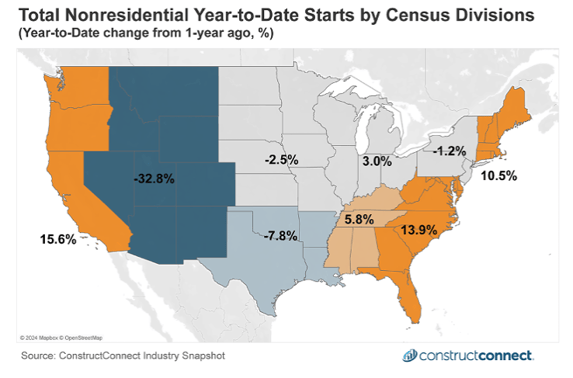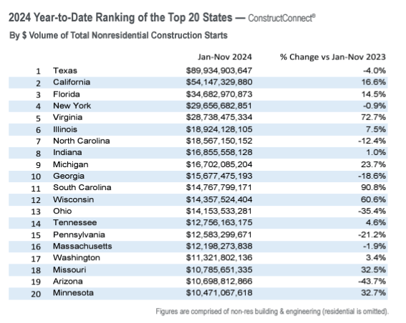Read this to understand the monthly dollar change in US construction activity by area
ConstructConnect Chief Economist Michael Guckes reported in the December Construction Economy Snapshot that regional, nonresidential construction activity was generally positive for many coastal regions but more difficult for the nation’s central and mountainous areas, year-to-date (YTD) through November 2024. These regions encompass the states between Idaho, Arizona, Louisiana, and Wisconsin.

Map of total nonresidential construction starts by US Census divisions. From ConstructConnect, The Construction Economy Snapshot through November 2024.
Guckes reported that through November, the YTD nonresidential construction spending expanded the fastest in the Pacific region, at 15.6%.
On the East Coast, gains have been strong across the South Atlantic, where YTD growth is up 13.9%.
Further up the coast, states in the New England region have reported total growth of 10.5%. In contrast to the powerful expansions along both coasts, mountain and plains states continue to struggle when measured by total nonresidential starts spending.

Chart of 2024 Year-to-Date Ranking of the Top 20 US States. Ranked by dollar volume of total nonresidential construction starts. From ConstructConnect, The Construction Economy Snapshot through November 2024.
The most affected area is the region of the eight mountain states in the rectangle formed by Idaho, Arizona, New Mexico, and Montana. Here, YTD’s total nonresidential starts spending has fallen by 33%. Seven of the eight states in this region have reported contracting YTD results.
Moving further East across the country, Guckes writes, conditions steadily improve, moving from mild negative results in the central plains states to mildly positive results in the Midwest and Ohio River Valley.
The economist said that Heavy Engineering and Civil construction activity have been a bright spot for much of the country during 2024. Growth in these regions has been explosive, with regional results in the Pacific up 31%, New England gaining 36%, and the South Atlantic adding 48%.
Heavy construction has also been a bright spot for many plains and midwestern states this year, helping to offset contracting nonresidential building results. In the states ringed by North Dakota, Nebraska, Missouri, and Minnesota, civil construction is up 14% YTD. This is followed by 8.1% growth in the mountain states that were previously identified.
Close behind is the East South Central region, which includes Kentucky, Tennessee, Alabama, and Mississippi, growing at 7.8%.

About ConstructConnect
At ConstructConnect, our software solutions provide the information that construction professionals need to start every project on a solid foundation. For more than 100 years, our keen insights and market intelligence have empowered commercial firms, building product manufacturers, trade contractors, and architects to make data-driven decisions, streamline preconstruction workflows, and maximize their productivity. Our newest offerings—including our comprehensive, AI-assisted software—help our clients find, bid on, and win more projects.
ConstructConnect operates as a business unit of Roper Technologies (Nasdaq: ROP), a constituent of the Nasdaq 100, S&P 500, and Fortune 1000.
For more information, visit constructconnect.com.
